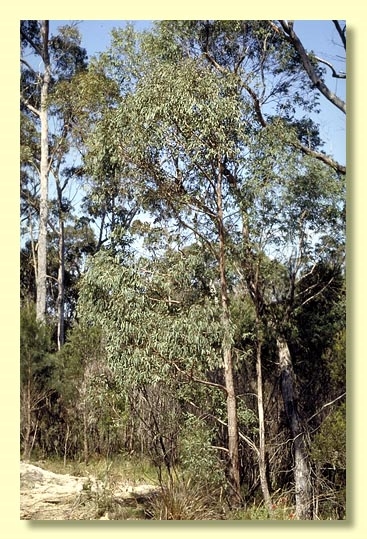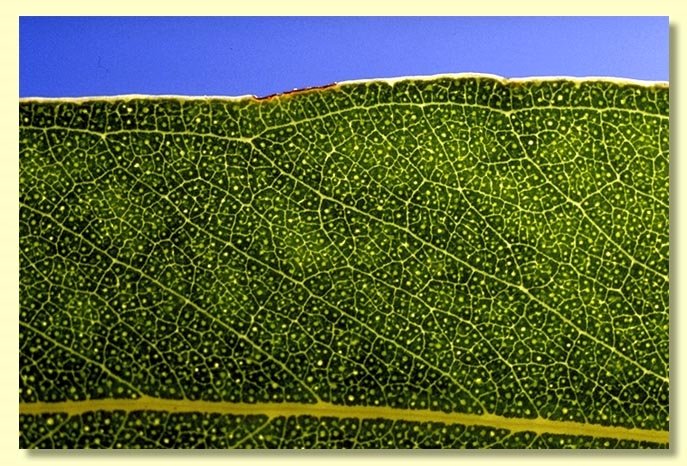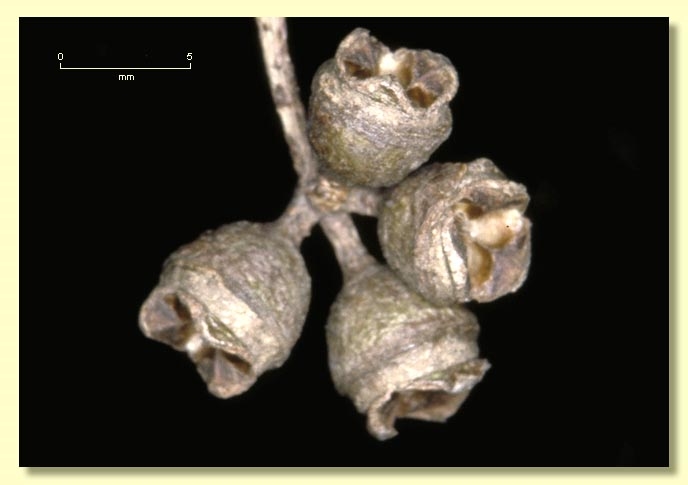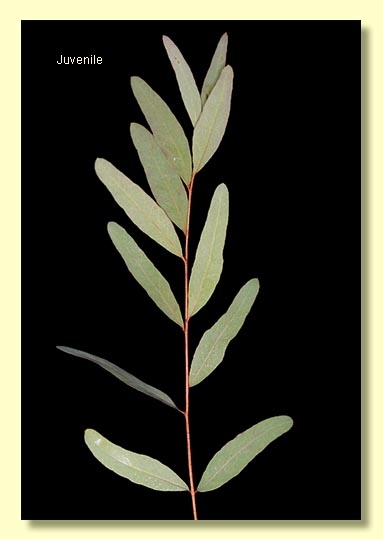Eucalyptus | Symphyomyrtus | Maidenaria | Triangulares | Acaciiformes
Euclid - Online edition
Eucalyptus ignorabilis
T: Victoria, 4.6 km W of Seaton, 19 Feb. 1986, K.D.Hill 1401 & L.A.S.Johnson; holo: NSW; iso: CANB, MEL, PERTH.
Bark on trunk and branches rough, firm, fibrous, with interlocking fissures, spongy, grey or brown, smaller branches shedding in ribbons.
Juvenile stem rounded in cross-section, slightly warty or smooth; juvenile leaves always sessile and opposite at first but very shortly petiolate by node ca 16, inconsistently opposite or alternate well into small sapling stage (< 2 m tall), lanceolate to oblong to elliptical to falcate, 2.8–9 cm long, 0.5–2.3 cm wide, margin entire or crenulate, tapering to petiole, dull, green.
Adult leaves alternate, petiole 0.6–2.7 cm long; blade lanceolate to falcate, 7–20 cm long, 1–3 cm wide, base tapering to petiole, concolorous, dull, green to grey-green, side-veins at an acute or wider angle to midrib, densely reticulate, intramarginal vein parallel to and well removed from margin, oil glands island and intersectional.
Inflorescence axillary unbranched, peduncles 0.3–1 cm long, buds 7 per umbel, pedicels 0.1–0.3 cm long. Mature buds ovoid to fusiform, 0.4–0.5 cm long, 0.2–0.3 cm wide, green to yellow, smooth, scar present, operculum rounded to slightly beaked to conical, stamens inflexed, anthers cuboid to oblong, versatile, dorsifixed, dehiscing by longitudinal slits (non-confluent), style long, stigma blunt or tending to pin-head shaped, locules 3 or 4, the placentae each with 4 vertical ovule rows. Flowers white.
Fruit pedicellate (pedicels 0.1–0.3 cm long), cup-shaped to hemispherical, 0.3–0.5 cm long, 0.4–0.7 cm wide, disc raised-convex to annular or oblique to vertical, valves 3 or 4, broad, exserted or near rim level.
Seeds black, brown or grey, 1.5–2.5 mm long, ovoid or flattened-ovoid, often pointed at one end, lacunose, dorsal surface smooth or shallowly pitted, hilum ventral.
Cultivated seedlings (measured at ca node 10): cotyledons oblong to bilobed; stems rounded in cross-section, warty or smooth; leaves sessile or very shortly petiolate, opposite for 6 to 12 pairs then becoming alternate, narrowly elliptic-oblong, 4–8.2 cm long, 0.6–2.2 cm wide, base rounded to tapering, margin entire, apex rounded or pointed, concolorous, dull, green to grey-green.
Flowering has been recorded in January and April.
An uncommon small to medium-sized tree of very scattered distribution in Victoria on ranges and subcoastal foothills, collected from near north of Erica where plentiful, Toongabbie, Seaton (near Heyfield), south of Cann River town and disjunctly in far south-eastern New South Wales near Timbillica. E. ignorabilis has finely fibrous rough bark throughout, dull green lanceolate adult leaves and green oblong to lanceolate juvenile leaves.
Eucalyptus ignorabilis has been confused with other species but juvenile growth will help the botanist sort things out. Fine-leaved rough-barked trees in the Mallacoota and Genoa area that have been referred to E. ignorabilis are in fact E. cephalocarpa, based on the sessile, cordate, glaucous juvenile foliage (oblong-lanceolate, non-glaucous and shortly petiolate in E. ignorabilis ). The adult leaves of E. ignorabilis are dull, distinguishing it from the related species, E. fulgens, which has glossy green leaves, more coarsely furrowed bark and occurs from Healesville to the Latrobe Valley. Another related species is E. aromaphloia (with two subspecies), which occurs further to the west in Victoria, and has similar bark to E. fulgens and a dull-leaved crown rather like E. ignorabilis.
Eucalyptus ignorabilis belongs Eucalyptus subgenus Symphyomyrtus section Maidenaria, a large group of species more or less restricted to south-eastern Australia, characterised by bilobed cotyledons, simple axillary inflorescences, buds with two opercula, stamens with versatile anthers and flattened seeds with a ventral hilum. Within this section E. ignorabilis and five other species form series Acaciiformes diagnosed by the rough bark, juvenile leaves that are soon alternate, glandular adult leaves, non-swampy habitat, and small fruit with valves at least slightly exserted. Three of these species, E. ignorabilis, E. aromaphloia and E. fulgens, are restricted to Victoria and far south-eastern New South Wales and differ as discussed above.

















